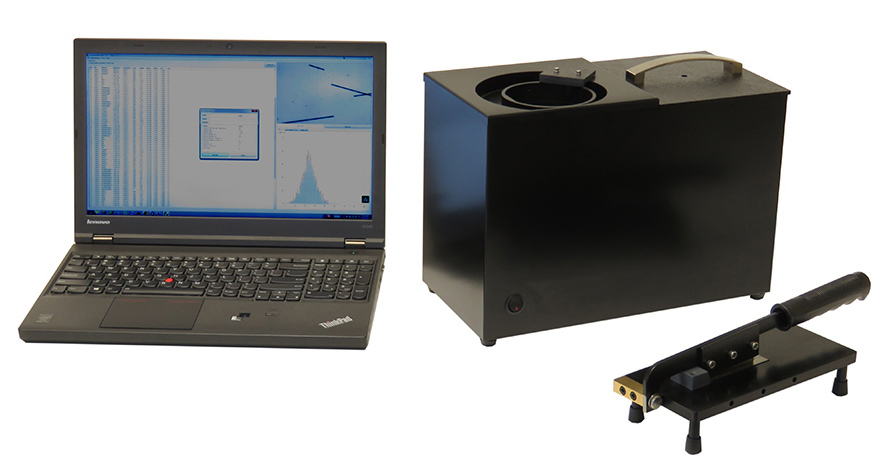Maximize Your Fiber Optic Performance: Comprehending Optical Fibre Diameter Analyser Technology
The performance of fibre optic systems is critically affected by the accuracy of their size, a factor often neglected in the search of optimum signal integrity. Recognizing the innovation behind optical fiber size analysers exposes the detailed equilibrium between measurement precision and production quality.
Relevance of Optical Fiber Size
The size of optical fibre plays an important duty in determining the performance and efficiency of communication systems. It influences numerous crucial parameters, consisting of the mode of light propagation, depletion, and bandwidth capacity. Bigger sizes usually allow for numerous light modes, facilitating greater information transmission prices. Conversely, smaller sized sizes tend to support less settings, which can boost signal clearness and lower crosstalk.

Additionally, comprehending the diameter's effects can bring about set you back financial savings by minimizing the need for signal boosting and repeaters in substantial networks (optical fibre diameter analyser). Finally, the value of optical fibre size can not be overemphasized, as it straight impacts the total performance and reliability of modern communication systems

Just How Diameter Impacts Signal Quality
Signal high quality in optical fibre systems hinges substantially on the size of the fiber. A smaller sized diameter can lead to greater depletion prices, resulting in signal loss as light journeys through the fibre.
Conversely, larger diameters usually enable boosted light capture and decreased modal diffusion, enhancing signal clarity. In multimode fibers, a larger core size can support several light settings, yet it may additionally introduce intermodal diffusion, which can deteriorate signal top quality. Picking the ideal fibre size is crucial for accomplishing the preferred performance in certain applications.
Furthermore, the interaction in between the fiber size and the wavelength of the light utilized plays an important role in determining the reliable transmission distance and general signal honesty. Thus, understanding how fibre size impacts signal top quality is crucial for network designers and designers aiming to optimize optical fibre systems for trustworthy, high-speed data transmission.
Overview of Size Analyser Technology
In lots of optical fibre production processes, accurate measurement of fiber diameter is necessary for ensuring constant performance and quality (optical fibre diameter analyser). Size analysers are sophisticated instruments made to evaluate the physical dimensions of optical fibers with high accuracy. They utilize advanced optical and laser innovations to determine the size, ovality, and concentricity of the fibre, therefore giving vital data for top quality control
These analysers can operate in-line during the production procedure or as part of off-line testing procedures. In-line systems allow real-time tracking, enabling makers to readjust parameters promptly, thereby maintaining optimal production conditions. Off-line analysers, on the other hand, give extensive assessments of batches, guaranteeing that any kind of deviations from specified tolerances are determined and addressed.
Diameter analysers considerably add to the reduction of flaws in optical fibers, improving overall item reliability. By regularly determining vital specifications, these innovations facilitate find out here conformity with sector standards and specs. As the demand for high-performance optical fibers continues to increase, the duty of diameter analysers comes to be significantly essential in attaining the preferred high quality and performance standards in fiber optic systems.
Secret Features of Fiber Diameter Analysers
Although different versions of fibre diameter analysers exist, they typically share several crucial functions that improve their capability and reliability. One of the most significant functions is high-resolution dimension abilities, which make sure exact size readings, essential for preserving quality assurance in fiber manufacturing. In addition, several analysers incorporate advanced optical sensing units designed to find minute variations in fibre diameter, hence offering vital information for procedure optimization.
One more important feature is real-time surveillance, allowing operators to obtain immediate comments on fibre diameter throughout the production process (optical fibre diameter analyser). This ability promotes rapid adjustments and lowers the possibility of issues. Lots of analysers also come equipped with user-friendly interfaces, enabling drivers to quickly navigate via information and settings outputs
Moreover, robust information storage space and evaluation functionalities are crucial for tracking historic performance fads and ensuring conformity with industry click to investigate standards. These attributes jointly add to the efficiency of fiber size analysers in enhancing fibre optic performance.
Finest Practices for Fiber Optimization

First, normal calibration of optical fiber diameter analysers is vital. This makes certain accurate dimensions and reduces prospective disparities that might impact performance. Next, maintaining a tidy workplace is essential; dirt and impurities can bring about signal degradation.
Furthermore, it is necessary to choose fibres that meet specific application needs. This includes assessing factors such as attenuation, bandwidth, and environmental problems. Appropriate installation methods should also be followed, consisting of preventing sharp bends and extreme stress, which can endanger fibre stability.
Additionally, using innovative surveillance systems can assist in real-time performance assessments, allowing prompt recognition of concerns. Normal screening and maintenance ought to be carried out to guarantee that Full Report fibers continue to be within optimal functional criteria.
Lastly, training workers on the current fibre optimization modern technologies and methodologies will certainly enhance their ability to apply effective methods. By complying with these finest practices, organizations can significantly boost the performance and life-span of their optical fibre systems, ensuring reliable communication and data transfer.
Final Thought
Finally, the assimilation of optical fiber diameter analyser technology is vital for making the most of fiber optic efficiency. By making sure accurate measurements of fibre dimensions, these analysers dramatically enhance signal quality and reduce losses throughout data transmission. Routine calibration and upkeep of the analysers are crucial to maintain optimum efficiency and compliance with industry criteria. Inevitably, the application of this modern technology promotes enhanced information transmission rates and enhances signal integrity, contributing to the general performance of fiber optic systems.
Signal top quality in optical fibre systems pivots substantially on the diameter of the fibre.In numerous optical fibre manufacturing processes, exact dimension of fiber size is necessary for guaranteeing constant performance and quality. As the need for high-performance optical fibers proceeds to rise, the duty of size analysers comes to be progressively important in achieving the wanted high quality and performance criteria in fiber optic systems.
These attributes collectively contribute to the efficiency of fibre size analysers in maximizing fiber optic efficiency.
In final thought, the assimilation of optical fiber size analyser modern technology is critical for making best use of fiber optic performance.